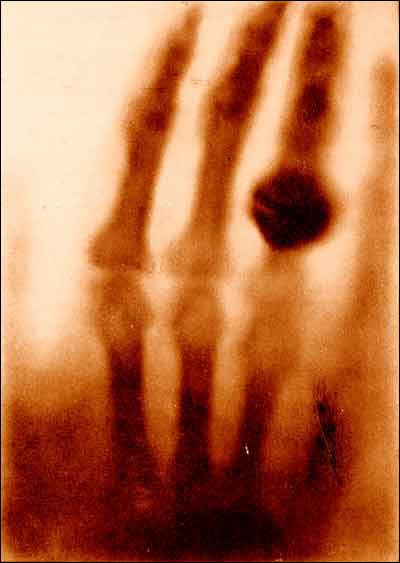Position: Historical scientist Field: Radiation Physics
The scene – a physics lab at the University of Wurzberg in Germany.
The date – 8 November 1895.
Wilhelm Röntgen was experimenting with a vacuum tube covered in black paper when suddenly he noticed that a piece of fluorescent paper was glowing. Normally, such a glow would be caused by ultraviolet light, but ultraviolet light would have been blocked by the black paper.
Roentgen decided some form of unseen rays was coming from the tube and that these mysterious rays needed further investigation. If black paper didn’t block the rays, what would? He tried different materials. Lead blocked the rays almost completely. Other materials blocked them if they were thick enough, but water didn’t block them at all.
At one point, his hand passed between the tube and the screen. He noticed that his hand created a shadow on the screen – but what a shadow! What he saw was the bones of his hands.
He tested different materials to see if they were also sensitive to the rays and discovered that photographic plates were. He took an X-ray photograph of his wife’s hand that clearly showed the bones of her hand as well as her wedding ring. This picture is probably the most famous X-ray ever taken, but his wife was rather taken aback by this image of her hand – to her, it was a premonition of her death.
Nearly two months after he made his first discovery, he wrote an article where he outlined the results of his discovery. In the article, he called his discovery X-rays, because they were a previously unknown form of radiation. On New Year’s Day, he posted out the article to several prominent scientists around the world.
It wasn’t just scientists and doctors that were excited by the new technology. The news of the discovery was leaked to the press in early January and quickly spread around the world.
By the end of the week, X-rays had been used in Berlin to locate a piece of glass that had been stuck in a girl’s hand for six months. By the end of the year, X-ray equipment had been imported into New Zealand and used to treat patients by a GP in Masterton. Roentgen was asked by the Kaiser to demonstrate the new rays to him, and he received many prizes for his discovery, including the first Nobel prize for Physics in 1901.
Nature of science
Many great scientific discoveries have come from observations of unintended happenings, mistakes or accidents. These occurrences have often led the scientist in an unexpected direction. It takes powers of observation and an open and curious mind to take advantage of these chances.
Useful link
Roentgen’s article On A New Kind Of Rays (translated from Über eine neue Art von Strahlen).
Activity idea
In this activity, Discovery and development of x-rays, students learn about the discovery of X-rays and their development as a medical imaging technology.


